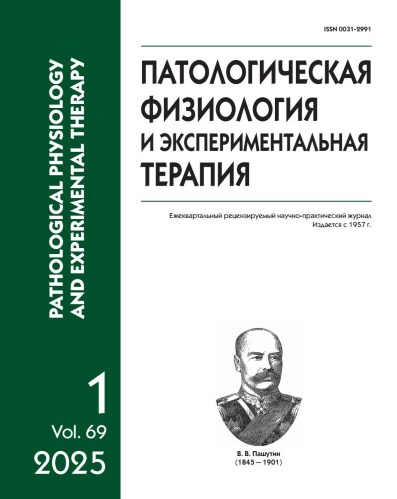Coagulant effects of chitosan composites with amino acids (aspartic acid, glutamic acid, cysteine) in vitro
Abstract
Introduction. One of the problems of modern medicine and physiology is the normalization of blood clotting processes in both healthy individuals and patients, especially in the conditions of hypocoagulation. The polysaccharide chitosan is known for its combination of hemostatic, antioxidant, wound healing, etc., properties. The aim was to obtain the most effective compound of chitosan (CHTZ) with amino acids in terms of the coagulant properties and to study its effect on the hemostasis system in vitro.
Methods. The coagulant properties of three new composites (compounds) of CHTZ with the amino acids, aspartic acid (AA), glutamic acid (GA), and cysteine (C), were studied in in vitro experiments. The coagulation study methods included the tests for primary hemostasis (platelet aggregation test) and secondary hemostasis (activated partial thromboplastin time, APTT; thrombin time, TT; and prothrombin time, PT). Blood samples were withdrawn from rats under zolethyl-xylazine anesthesia (zolethyl 15 mg/kg, xylazine 8 mg/kg body weight, i.m.).
Results. All the studied compounds produced a hemostatic effect as compared to the control saline. The values of activated platelet aggregation exceeded the values in the control group maximally by 13, 16 and 25% under the action of the compounds CHTZ-AA, CHTZ-GA and CHTZ-C, respectively. These composites also significantly enhanced plasma hemostasis. Thus, CHTZ-C maximally reduced the TT by 32% and the PT by 10% vs. control. The CHTZ-AA composite suppressed the APTT by 14% and the PT by 19%, while the CHTZ-GA composite shortened the PT by 25% relative to the control.
Conclusion. The CHTZ-C composite was the best coagulant by the effect on primary hemostasis; the best effects on plasma hemostasis were noted for CНTZ-GА by the effect on the external coagulation pathway, CНTZ-AА by the effect on the internal coagulation pathway, and CTZ-C by the effect on the general blood coagulation pathway.
Downloads
References
1. Chou Tz.-C., Fu E., Wu C.-J., Yeh J.-H. Chitosan enhances platelet adhesion and aggregation. Biochem. Biophys. Res. Commun. 2003; 302 (3): 480–83. https:// doi.org/ 10.1016/s0006-291x(03)00173-6.
2. Wang C.H., Cherng J.H., Liu C.C. et al. Procoagulant and Antimicrobial Effects of Chitosan in Wound Healing. Int. J. Mol. Sci. 2021; 22 (13):7067. https:// doi.org/0.3390/ijms22137067.
3. Ilyas R.A., Aisyah Н.А., Nordin А.Н. et al. Natural-Fiber-Reinforced Chitosan, Chitosan Blends and Their Nanocomposites for Various Advanced Applications. Polymers (Basel). 2022; 14 (5): 874. https:// doi.org/ 10.3390/polym14050874.
4. Moeini A., Pedram P., Makvandi P. et al. Wound healing and antimicrobial effect of active secondary metabolites in chitosan-based wound dressings: A review. Carbohydr. Polym. 2020; 233(115839). https:// doi.org/ 10.1016/j.carbpol.2020.115839.
5. Casettari L., Vllasaliu D., Lam J.K.W. et. al. Biomedical applications of amino acid-modified chitosans: a review. J. Biomaterials. 2012; 33(30): 7565-83. https:// doi.org/ 10.1016/j.biomaterials.2012.06.104.
6. Zhang W., Zhong D., Liu Q. et al. Effect of chitosan and carboxymethyl сhitosan on fibrinogen structure and blood coagulation. J. Biomater. Sci. Polym. 2013; 24(13): 1549–63. https:// doi.org/ 10.1080/09205063.2013.777229.
7. Guo X., Sun T., Zhong R. et al. Effects of Chitosan Oligosaccharides on Human Blood Components. Front. Pharmacol. 2018; 9: 1412. https:// doi.org/ 10.3389/fphar.2018.01412
8. Yakubke H.D., Eshkait H., Amino acids, peptides, proteins. [Aminokisloti, peptidi, proteini]. M.: Mir; 1985. (in Russian)
9. Srivastava Arvind, O'Dell Courtney, Bolessa Evon et al. Viscosity Reduction and Stability Enhancement of Monoclonal Antibody Formulations Using Derivatives of Amino Acids. J Pharm Sci. 2022; 111(10): 2848-56. https:// doi.org/ 10.1016/j.xphs.2022.05.011.
10. Radwan-Pragłowska J., Piątkowski M., Deineka V. et al. Chitosan-Based Bioactive Hemostatic Agents with Antibacterial Properties-Synthesis and Characterization. Molecules. 2019; 24 (14): 2629. https:// doi.org/ 10.3390/molecules24142629.
11. Chen D., Liu X., Qi Y. et al. Poly(aspartic acid) based self-healing hydrogel with blood coagulation characteristic for rapid hemostasis and wound healing applications. Colloids Surf. Biointerfaces. 2022; 214: 112430. https:// doi.org/: 10.1016/j.colsurfb.2022.112430.
12. Lysikov Yu.A. Amino acids in human nutrition. Amino acids in human nutrition. Let's experiment. and a wedge. gastroenterol.. 2012; 2: 88-105 (in Russian).
13. Hamedinasab H., Rezayan A.H., Jaafari M.R.. et al The protective effect of N-acetylcysteine against liposome and chitosan-induced cytotoxicity. J Microencapsul. 2023; 40(5): 357-365. https:// doi.org/10.1080/02652048.2023.2209646.
14. Bian Dejian , Chen Zheng, Ouyang Yongliang et al. Ultrafast self-gelling, sprayable, and adhesive carboxymethyl chitosan/poly-γ-glutamic acid/oxidized dextran powder for effective gastric perforation hemostasis and wound healing Int. J. Biol. Macromol . 2024; 254(3): 127960. https:// doi.org/ 10.1016/j.ijbiomac.2023.127960.
15. Struchkova I.V., Brilkina A.A. Amino acids. Educational and methodical manual.[Aminokisloti. Uchebno-metodicheskoe posobie]. Nizhny Novgorod: Nizhny Novgorod State University; 2016. (in Russian)
16. Barkagan Z.S., Momot A.P. Diagnostics and controlled therapy of the hemostasis system. [Diagnostika i controliruemaya terapiya sistemy genostasa]. M.: Newdiamed; 2008. (in Russian)
17. Lyapina L.A., Grigorieva M.E., Obergan T.Yu., Shubina T.A. Theoretical and practical issues of studying the functional state of the anticoagulant blood system. [Teoreticheskie i prakticheskie voprosyizucheniya funktsional’nogo sostoyaniya protivosvertyvayushchey sistemy krovi]. Moscow: Advanced Solutions; 2012. (in Russian)
18. Periayah M.H., Halim A.S., Yaacob N.S. et al. The induction of glycoprotein IIb/IIIa and P2Y12 by oligochitosan accelerates platelet aggregation. Biomed. Res. Int. 2014; (653149). https:// doi.org/ 10.1155/2014/653149.
19. Kuznik B.I. Cellular and molecular mechanisms of regulation of the hemostasis system in norm and pathology. [K;etochnii I molecularnii mechanism sisteni gemostasa v norme b patologii]. Chita: Express Publishing House; 2010. (in Russian)
20. Shen E.C., Chou T.C., Gau C.H. et al. Кelease of growth factors from activated human platelets after chitosan stimulation: a possible biomaterial for the preparation of platelet-rich plasma. Clin. Oral. Implants. Res. 2006; 17 (5): 572–78. https:// doi.org/ 10.1111/j.1600-0501. 2004. 01241.x.
21. Hu Z., Zhang D.Y., Lu S.T. et al. Chitosan-based composite materials for promising hemostatic applications. Mar Drugs. 2018; 16 (8): 273. https:// doi.org/ 10.3390/md16080273.






